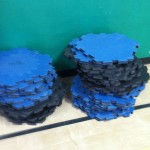Tchoukball Relay
Setup and Equipment
- Four Tchoukball (Chookball) Frames

- Four balls: Playground Balls (any kind will work)
- Four Cones red, blue, yellow, and green cones lined up facing the goal
- Make 3 lines on the blacktop about 5 feet in front of the goals. Make a second line about 10 feet back and the third 15 – 20 feet back. Use sidewalk chalk, poly spots or jump ropes.
Guidelines:
- Teams are lined up facing the goals. This is a relay. If the ball is thrown directly in the center the ball it should bounce into the air and you should try to catch it on a fly. You also get points if you catch it on one bounce.
- The first person on each team will move the ball by running to the first, second or third lines and throw the ball at the net. More points are earned by attempting the longer throws.
Round 1:
- The first person on each team will move the ball by running to the first line or spot near the goal and attempt to throw the ball at the center of the goal.
- If the ball is thrown directly in the center the ball it should bounce into the air and you should try to catch it on a fly. You also get points if you catch it on one bounce.
- You earn 1 point for throwing and catching it on a fly and from the first line.
- You earn 2 points by throwing and catching it from the second line on a fly and one point if you catch it on a bounce.
- If you throw and catch it on a fly from the three-point line you get three points. If you catch it on a bounce you get 2 points.
- Continue for five minutes and see how many points your team can get.
Round 2: Partner
- The first two people on each team will move the ball by running to one of the lines. One person is the thrower and one is the catcher.
- Use the same point system as above.
Continue for five minutes and see how many points your team can score.
Round 3: Partner Variation
- One partner runs up and throws the ball and the other partner tries to catch it. On each turn switch the roles of throwing and catching.
Younger Grades: For the younger grades you won’t need to do the points. They’ll just enjoy seeing how far they can bounce the ball.
Variations: Round Three: Try different balls. How about basketballs, soccer balls?
The Most Fun Wins!


